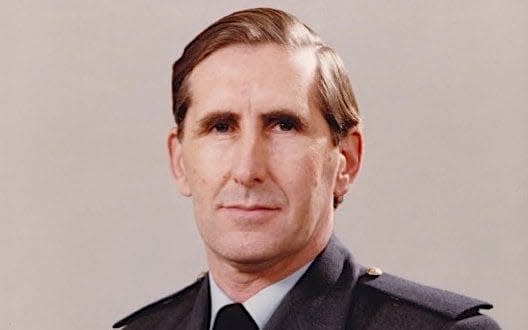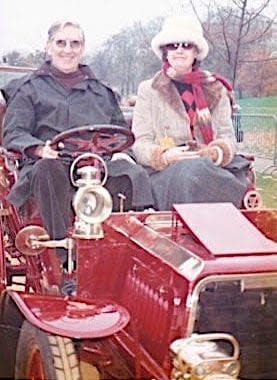Air Chief Marshal Sir John Rogers, Cold War fighter pilot who later oversaw procurement of all military aircraft and associated weapon systems – obituary

Air Chief Marshal Sir John Rogers, who has died aged 93, was a former aircraft apprentice and Cold War fighter pilot who rose to serve on the Air Force Board of the Defence Council.
Rogers became Controller Aircraft (CA) in the MoD in January 1983, a job in which he was responsible for the procurement of all military aircraft and associated weapon systems – a complex process involving, political, industrial and financial interests.
A new aircraft type could not be used by the forces without a CA Release, which Rogers would issue once all the necessary system testing had been satisfactorily carried out. CA was also responsible for post design services on in-service aircraft.
Rogers worked closely with industry and the MoD’s procurement executive. He met regularly with all his project directors and conducted individual reviews with them every quarter. He was regarded as strict but very knowledgeable and fair by all his staff.
Among many other projects at that time, he had the overall responsibility for the procurement of the Tornado and Hawk aircraft, and the in-service support for the Phantom and Buccaneer aircraft.
John Robson Rogers was born in Brentwood, Essex on January 11 1928. He was educated at Brentwood School and in 1944 joined the RAF as an aircraft apprentice.
For three years he trained as a ground radio fitter. He finished near the top of the order of merit and was awarded a cadetship at the RAF College Cranwell where he completed his training as a pilot. He was commissioned in April 1950 and began training as a night fighter pilot.
Rogers’ long association with fighter aircraft commenced when he joined 141 Squadron, which was equipped with the Mosquito. After six months he headed for Egypt where he joined 219 Squadron, based at Kabrit in the Canal Zone, and where he became the squadron’s tactics instructor.
With regular detachments to Malta, Cyprus, Libya and Iraq, three months of the year was spent away from his base on the shores of the Great Bitter Lakes. Before leaving Egypt, the Mosquitos were replaced by the night-fighter version of the twin-engine Meteor jet fighter.
On his return to Britain after three years in Egypt, he joined the All Weather Development Squadron of the Central Fighter Establishment. The Meteor was still operational but was being replaced by the delta-wing Gloster Javelin, and Rogers and his fellow aircrew were responsible for devising and developing all-weather and night fighting tactics.
By 1956 he was a highly experienced and accomplished fighter pilot and was sent to the USAF’s Tyndall Air Force base in Florida for three years to train pilots and weapons system operators on all-weather and night fighters.
His return to Britain in January 1960 saw him appointed to command 56 Squadron at Wattisham in Suffolk. The squadron was flying the Hunter, but by the end of the year it began to receive the new supersonic Lightning aircraft. Fully equipped by the following spring, the squadron carried out a number of long-range flights pioneering the use of air-to-air refuelling.
After serving as the personal staff officer to the Commander-in-Chief Fighter Command, Rogers took command of the Air Fighting Development Squadron at the Central Fighter Establishment. The latest version of the Lightning was entering service and Rogers flew many trial flights.
In early 1965, the then Labour Government cancelled a number of projects including the replacement for the RAF’s long-serving Hunter. It was decided to procure the US-built Phantom powered by Rolls-Royce Spey engines.
With his previous experience of service with the USAF, and his wide experience of fighter operations, Rogers left for Washington in April 1965 to be the RAF Phantom Procurement Manager, a post he held for almost three years, to oversee an initial order for 200 aircraft, later substantially reduced.
In February 1968, he became the station commander at RAF Coningsby, the base selected for the first Phantom units. He first oversaw the considerable work programme to prepare the former V-bomber base for Phantom operations. The first aircraft arrived direct from the US in August and flying training began almost immediately. By the time Rogers relinquished command, two squadrons and a training unit were operational.

In August 1970 he moved to HQ 38 Group as group captain operations, the parent group for the Phantom squadrons, in addition to other front-line squadrons. On promotion to air commodore, he served as a director of operational requirements in MoD.
Rogers returned to the RAF College Cranwell in January 1974 to take up the post of Deputy Commandant. He was also responsible for the newly established Department of Air Warfare, which provided specialist courses in air weapons, navigation and electronic warfare.
After attending the 1976 Royal College of Defence Studies course, he was promoted to air vice-marshal to become the Director General of Organisation in MoD. In November 1979 he became the Air Officer Commanding Training Units, which gave him responsibility for supervising all aspects of air and ground training in the RAF. A proud moment came when he presented his son David with his pilot’s wings.
Rogers was appointed to the Air Force Board in July 1981 as the Air Member for Supply and Organisation his responsibilities including engineering, equipment and RAF organisation and the RAF Regiment. After 18 months in post, and promotion to air chief marshal, he remained on the Air Force Board to take up the appointment of Controller Aircraft.
He retired from the RAF in March 1986 having been appointed CBE (1971) and KCB (1982). He was elected a Fellow of the Royal Aeronautical Society in 1983.
During his RAF career he maintained his long-standing interest in motorsport, and in the late 1980s took part in many events at Silverstone, Brands Hatch, Cadwell, and Donington Park. By this time, he had acquired LM6, a 1931 Aston Martin Team car, and regularly featured in races in the same event as his two sons who took it in turns to drive their second Aston Martin Le Mans.

His motoring hobby eventually turned into a second career and in 1986 he became a director of David Wickens’ British Car Auctions, which encouraged him to renew collecting. His daughter’s wedding became a spur to buy a 1923 Rolls Royce. His job took him all over the world to different motoring events, and he regularly competed in classic car trials.
His involvement in the organisation of the Brighton Run led him to take part driving an Orient Buckboard, which he described as, “Not my shrewdest choice. We never got to Brighton. My sons picked me up and we decided to get a serious motor car.” He acquired a 1904 Darracq.
Rogers considered himself to be a “rebuilder” rather than a “restorer”. He acknowledged that he was no purist and commented: “I like things original but it is not a fetish. Cars are for driving. I like to drive them and I like something to do with them. That’s why I like the RAC’s three classic car runs.”
In 1989 he became the executive chairman of RAC Motor Sports Association, a position he held for 10 years before being made a Life Vice-President. In 1995 he became a member of the Federation International d’Automobile (FIA) World Motor Sport Council, a role which took him to many international Formula 1 motorsports events as governing official and UK representative.
In 1955 John Rogers married Elspeth Campbell. She survives him with their two sons and two daughters.
Air Chief Marshal Sir John Rogers, born January 11 1928, died October 11 2021
